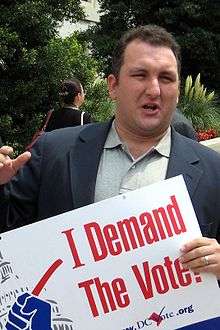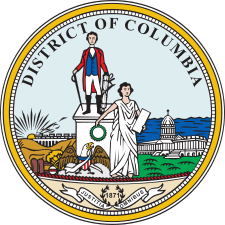Shadow congressperson
The posts of shadow United States Senator and shadow United States Representative are held by elected or appointed government officials from subnational polities of the United States that lack congressional vote. While these officials are not seated in either chamber of Congress, they seek for their subnational polity to gain voting rights in Congress.
History
Historically, shadow congressmen were elected by organized incorporated territories prior to their admission to the Union.[1][2] From its origins in Tennessee, this approach is sometimes known as the Tennessee Plan.
The first shadow senators, William Blount and William Cocke of the Southwest Territory, were elected in March 1796, before being seated as senators representing the newly formed state of Tennessee. Michigan, California, Minnesota, Oregon, and Alaska likewise elected shadow senators before statehood. The Alaska Territory also elected the first shadow U.S. representative, Ralph Julian Rivers, in 1956. All were eventually seated in Congress as voting members, except for Alaska shadow senator William A. Egan, who instead became governor.[1] The election of shadow congresspersons from the District of Columbia is authorized by a "state" constitution, which was ratified by D.C. voters in 1982 but was never approved by Congress.[3]
District of Columbia officeholders
District of Columbia shadow senators
The voters of the District of Columbia elect two shadow U.S. senators who are known as U.S. senators by the District of Columbia, but who are not officially sworn or seated by the U.S. Senate. Shadow U.S. senators were first elected in 1990.
The current shadow United States senators from the District of Columbia are Paul Strauss and Mike Brown.[4]
|
Class 1 Class 1 U.S. senators belong to the electoral cycle recently contested in 1994, 2000, 2006, 2012 and 2018. The next election will be in 2024. |
C |
Class 2 Class 2 U.S. senators belong to the electoral cycle recently contested in 1996, 2002, 2008, and 2014. The next election will be in 2020. | ||||||||||
|---|---|---|---|---|---|---|---|---|---|---|---|---|
| # | Senator | Party | Dates in office | Electoral history | T | T | Electoral history | Dates in office | Party | Senator | # | |
| 1 | Florence Pendleton | Democratic | January 3, 1991 – January 3, 2007 |
Elected in 1990. | 1 | 102nd | 1 | Elected in 1990. Retired. |
January 3, 1991 – January 3, 1997 |
Democratic |  Jesse Jackson |
1 |
| 103rd | ||||||||||||
| Re-elected in 1994. | 2 | 104th | ||||||||||
| 105th | 2 | Elected in 1996. | January 3, 1997 – present |
Democratic | .jpg) Paul Strauss |
2 | ||||||
| 106th | ||||||||||||
| Re-elected in 2000. Lost re-election. |
3 | 107th | ||||||||||
| 108th | 3 | Re-elected in 2002. | ||||||||||
| 109th | ||||||||||||
| 2 |  Mike Brown |
Democratic | January 3, 2007 – present |
Elected in 2006. | 4 | 110th | ||||||
| 111th | 4 | Re-elected in 2008. | ||||||||||
| 112th | ||||||||||||
| Re-elected in 2012. | 5 | 113th | ||||||||||
| Independent | 114th | 5 | Re-elected in 2014. | |||||||||
| Democratic | 115th | |||||||||||
| Re-elected in 2018. | 6 | 116th | ||||||||||
| 117th | 6 | To be determined in the 2020 election. | ||||||||||
| 118th | ||||||||||||
| To be determined in the 2024 election. | 7 | 119th | ||||||||||
| # | Senator | Party | Years in office | Electoral history | T | T | Electoral history | Years in office | Party | Senator | # | |
| Class 1 | Class 2 | |||||||||||
District of Columbia shadow representatives
The voters of the District of Columbia elect one shadow representative who is recognized as equivalent to U.S. representatives by the District of Columbia, but is not recognized by the U.S. government as an actual member of the House of Representatives. A shadow representative was first elected in 1990. The current shadow representative is Franklin Garcia.[5][6]
D.C.'s shadow U.S. representative should not be confused with the non-voting delegate who represents the District in Congress.
| Delegate | Party | Term | Congress | Electoral history |
|---|---|---|---|---|
| Charles Moreland | Democratic | January 3, 1991– January 3, 1995 |
102nd 103rd |
Elected 1990 |
 John Capozzi |
Democratic | January 3, 1995– January 3, 1997 |
104th | Elected 1994 |
| Sabrina Sojourner | Democratic | January 3, 1997– January 3, 1999 |
105th | Elected 1996 |
| Tom Bryant | Democratic | January 3, 1999– January 3, 2001 |
106th | Elected 1998 |
| Ray Browne | Democratic | January 3, 2001– January 3, 2007 |
107th 108th 109th |
Elected 2000 |
 Mike Panetta |
Democratic | January 3, 2007– January 3, 2013 |
110th 111th 112th |
Elected 2006 |
| Nate Bennett-Flemming | Democratic | January 3, 2013– January 3, 2015 |
113th | Elected 2012 |
 Franklin Garcia |
Democratic | January 3, 2015– January 3, 2021 |
114th 115th 116th |
Elected 2014 |
Puerto Rico officeholders
The posts of shadow representatives and senators for Puerto Rico were created in 2017 as part of the Puerto Rico Equality Commission[7] after the New Progressive Party gained control of both the executive and legislative branch and the results of the 2017 Puerto Rican status referendum. Pro-statehood governor Ricardo Rosselló appointed five shadow representatives and two shadow senators[8] with the advice and consent of the Senate of Puerto Rico.[9]
Puerto Rico shadow senators
|
Class |
C |
Class | ||||||||||
|---|---|---|---|---|---|---|---|---|---|---|---|---|
| # | Senator | Party | Dates in office | Electoral history | T | T | Electoral history | Dates in office | Party | Senator | # | |
| 1 | Zoraida Fonalledas | New Progressive/ Republican |
August 15, 2017 – present |
Appointed in 2017. | 1 | 115th | 1 | Appointed in 2017. | August 15, 2017 – present |
New Progressive/ Democratic |
.png) Carlos Romero Barceló |
1 |
| 116th | ||||||||||||
| # | Senator | Party | Years in office | Electoral history | T | T | Electoral history | Years in office | Party | Senator | # | |
| Class | Class | |||||||||||
Puerto Rico shadow representatives
| Year | Shadow Congressmembers | ||||
|---|---|---|---|---|---|
| 1 | 2 | 3 | 4 | 5 | |
| 2017 | Luis Fortuño (PNP/R) | Charlie Rodríguez (PNP/D) | Iván Rodríguez (I) | Pedro Rosselló (PNP/D) | Félix Santoni (PNP/R) |
| 2018 | Alfonso Aguilar (PNP/R) | ||||
| 2019 | Luis Berríos-Amadeo (I) | ||||
| 2020 | Vacant | ||||
- Luis Fortuño (PNP/R), August 15, 2017 – present
- Charlie Rodríguez (PNP/D), August 15, 2017 – present
- Iván Rodríguez (I), August 15, 2017 – August 20, 2018
- Luis Berríos-Amadeo (I), August 20, 2018 – present
- Pedro Rosselló (PNP/D), August 15, 2017 – July 22, 2019
- Vacant, July 22, 2019 – present
- Félix Santoni (PNP/R), August 15, 2017 – January 6, 2018
- Alfonso Aguilar (PNP/R), January 6, 2018 – present
See also
- District of Columbia voting rights
- District of Columbia statehood movement
- Federal voting rights in Puerto Rico
- Statehood movement in Puerto Rico
References
- Strauss, Paul. "A Brief History of the Shadow Senators of the United States". Paul Strauss – United States Senator for the District of Columbia. Archived from the original on February 11, 2003.
- "Puerto Rico's Tennessee Plan". AAF. Retrieved March 10, 2019.
- Sheridan, Mary Beth (May 29, 2008). "D.C. Seeks to Fund Lobbying Effort for a Voting House Member". The Washington Post. p. B01. Retrieved December 29, 2008.
- Election profiles Michael D. Brown (D), The Washington Post, 2006, retrieved, September 30, 2012.
- "District of Columbia Election Results". New York Times. December 17, 2014.
- "Franklin for DC". Franklin Garcia for DC. January 2, 2015.
- "Ley por la Igualdad y Representación Congresional de los Ciudadanos Americanos de Puerto Rico" [Act for Equality and Congressional Representation of the United States Citizens of Puerto Rico]. Act No. 30-2017 of June 5, 2017 (PDF) (in Spanish).
- Bernal, Rafael (August 15, 2017). "Puerto Rico swears in congressional delegation". The Hill. Washington, D.C.
- "Puerto Rico governor designates four members for Equality Commission". Caribbean Business. Guaynabo, Puerto Rico.
